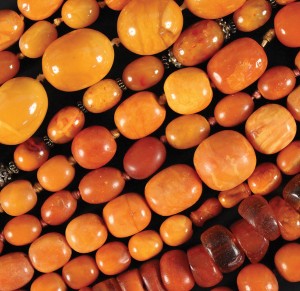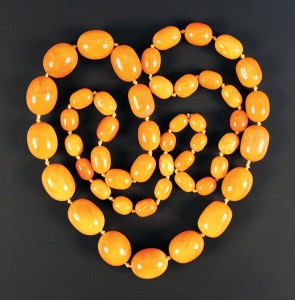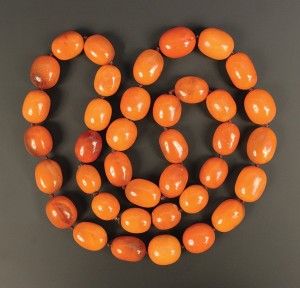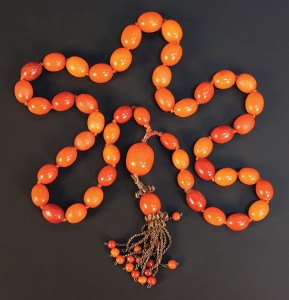



When collectors from China, India and the Middle East simultaneously decide to pursue the same collectors’ items, the effect on prices can be sudden and dramatic! In recent times the market for amber beads has been transformed with many thousands of pounds now being paid for the most sought-after examples.
Since the Neolithic period amber has been celebrated for its colour, beauty and supposed healing properties. In classical times, the Greeks called amber ‘electron’. According to myth, after the death of Phaethon, the son of Helios (the Sun), his sisters wept for him unceasingly and were changed into poplars. These trees continued to ooze tears, which were hardened by Helios into amber. This classical articulation of the origin of amber is not so far removed from our own understanding of amber as fossilised tree resin.
This sticky resin often captured insects and plant material, which can be seen in some examples of amber. The image of trapped insects in clear, golden amber found a place in contemporary culture at the heart of Michael Crichton’s novel ‘Jurassic Park’ and the subsequent film of the same title. Film fans amongst you will remember that in this story DNA extracted from the blood of a prehistoric mosquito preserved in amber was used to recreate dinosaurs.
Examples of amber with insect and plant inclusions were highly prized by Victorian collectors and aesthetes and until quite recently this transparent amber remained the most sought-after. But a recent change in fashion has resulted in another type of amber realising astonishing prices. It is less translucent with an almost milky quality to its appearance. ‘Butterscotch’ amber, as it is known, and its variants became fashionable in modern times during the 1920s. Interest has ebbed and flowed over the ensuing decades. Today this specific type of amber has captured the eye of collectors from the emerging economies of China, India and the Middle East, creating demand on a scale which was unimaginable only a short time ago.
This extraordinary change in the market has brought a good number of old amber necklaces to auction. Take, for example, the necklace arranged in the photograph as a heart. Comprising forty-nine mottled yellow butterscotch amber beads, weighing 278g and measuring 136cm in length, it sold in Toovey’s New Year’s Eve auction for £11,000 with competition from across the Near and Far East. The thirty-eight bead necklace illustrated, weight 255g, length 110cm, featured vari-coloured opaque and semi-translucent butterscotch amber beads and realised £10,000 in our January specialist jewellery sale a fortnight ago. The necklace of forty-seven brown and butterscotch amber beads, which realised £3,800 in November last year, was a favourite of mine. The beads had a flame-like quality to their appearance and were complimented by the charming tassel drop, finished with smaller beads.
Differences in prices paid for amber necklaces are largely attributable to the colour, number and size of the beads. They are not all as expensive to buy as these three; a reasonable example can still be found at auction for about £700. These days, though, you are as likely to find yourself up against a bidder from Mumbai or Beijing as you are against a bidder from London or the home counties. With global internet marketing providing a truly international shop window, these pieces are only a mouse-click away for specialist buyers across the globe and many in the emerging economies have deep pockets indeed at present. Another group of amber necklaces will be offered in our next specialist jewellery auction on Wednesday 26th February 2014.
By Revd. Rupert Toovey. Originally published on 12th February 2014 in the West Sussex Gazette.
One thought on “Amber: Prehistoric Treasure in Demand Today”
Comments are closed.